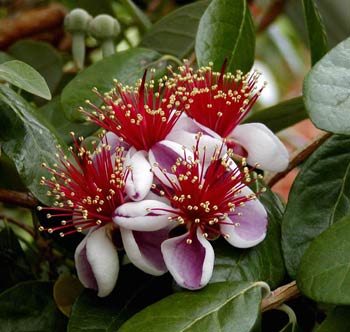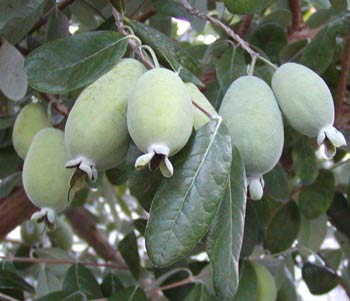Pineapple Guava
Feijoa sellowiana syn. Acca sellowiana
…for a blooming, fruit-bearing evergreen shrub

Common name: Pineapple Guava
Latin Name: Feijoa sellowiana syn. Acca sellowiana
Design Tip: Include one or more in a blooming mixed hedgerow or use as an evergreen backdrop to a mixed border. A specimen plant can be groomed into a single-trunk standard.
Form: This slow growing evergreen occurs naturally as a multi-stemmed shrub with gracefully curving trunks.
Size: Un-pruned shrubs grow ten to twelve feet tall.
Flowers: Clusters of exotic white petal-ed blooms, one to two inches wide, are centered with a red tassel of stamens topped with orbs of yellow pollen. Blooms occur in May on mature plants. Whole flowers make an attractive dish garnish. The sweet edible white petals can be used in salads or desserts.
Fruit: Three-inch long oval fruits have a minty-pineapple flavor that adds aromatic zest to cooked puddings, pies and jams. Raw feijoa fruit can be eaten fresh off the limb or used in desserts and salads. Peel the gray-green skin with knife or scoop the greenish white pulp out of halved fruits with a spoon. The fruit ripens 5 to 6 months after flowers appear.
Foliage: Evergreen three-inch long oval leaves are dark green above with silvery gray–green undersides to camouflage the fruit from below.
Soil: It will grow in a wide variety of soils, but performs best in a well-drained humus-rich soil. Mature plants become extremely drought tolerant, but best fruit and bloom develops with heavy spring rains or occasional deep irrigation.
Light Exposure: Plant in full sun to partial shade.
Cold Tolerance: A hardiness range is usually recommended for USDA Zones 8-10. In Zone 7B, protect new plantings through cold snaps below 10 degrees and site away from a northerly exposure.
Grooming: Pruning is not required to keep plants productive, but a light trimming in late winter will encourage new growth and increased yields the following year. When grown as a hedge or tree-let, the feijoa responds well to heavy pruning or shearing, but this reduces flower and fruit production.
Snippets: Feijoa sellowiana has been renamed Acca sellowiana, but most sources still use the older name. This member of the myrtle family is native to South America, from southern Brazil to northern Argentina.

Cultivated, photographed and written by
Maggie Ross McNeely in Fort Worth, Texas
All rights reserved